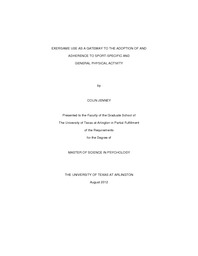| dc.description.abstract | Despite increasing the amount of information regarding the need for regular physical activity, rates of inactivity have not seen a corresponding decrease. The aim of the current study was to determine whether exergame use would serve as a gateway to the sport of racquetball, thereby providing a feasible and innovative way to influence behavior change regarding physical activity. The current study randomly assigned participants into one of three conditions for racquetball training: a no–exposure control group, a racquetball videogame (exergame) group, and a traditional training group. College aged adults (N = 103), who reported not being regular exercisers at recruitment and who had no prior experience with racquetball, followed the training method outlined by their group assignment for Weeks 0 – 4, after which all groups participated in the same, traditional racquetball training for Weeks 5 – 8. It was expected that the exergame group would have greater levels of skills test performance, general physical activity, fitness center use, levels of accelerometer activity, enjoyment, self–efficacy, and intention for physical activity. Concurrently, the exergame group was also expected to experience greater than or equal scores for these measures when compared to the traditional training group; supporting exergame use as either a superior or equivalent training method compared to the traditional training method. Furthermore, enjoyment and self–efficacy were expected to mediate the relationship between condition, and the physical and cognitive measures of physical activity. ANCOVA models revealed that the exergame group had greater skills test performance than the control group at T3 (for only males) and that no differences were found between the exergame and traditional training groups for the variables of enjoyment, skills test performance, racquetball self–efficacy, and activity (Weeks 5 – 8). However, greater enjoyment, self–efficacy measures, accelerometer activity, future intention, general physical activity and fitness center use were not seen for the exergame group above all other groups and the traditional training group was found to exhibit greater activity values on most outcomes. Analyses also discovered increases across time for all outcome variables regardless of group, with the exception of exercise self–efficacy. Due to these findings, the analyses testing exercise self–efficacy and enjoyment as mediators of group effects on the other outcomes could not be assessed. These results provide partial support for the novel use of exergames as a gateway to physical activity, and provide guidelines for future research to consider including gender, background exercise experience, and specific activity oriented differences. | |


